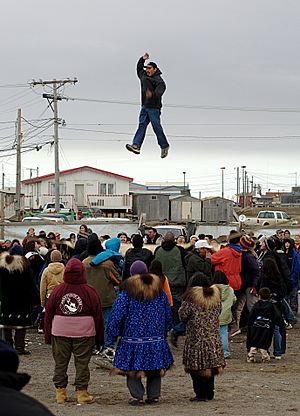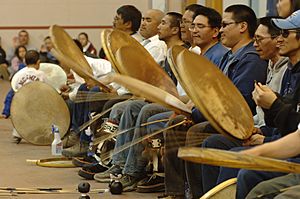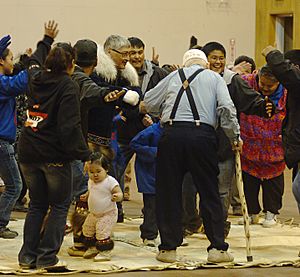Nalukataq facts for kids

Nalukataq is a special spring festival held by the Iñupiat people in Northern Alaska. It's mainly celebrated in the North Slope Borough. The word "Nalukataq" means "to throw it underhand" or "to toss it up." This name comes from the exciting Eskimo blanket toss, which is a big part of the festival.
Nalukataq marks the end of the spring whale hunting season. It brings the whole community together. People come to enjoy tasty whale meat, called muktuk, and to join in the blanket toss. The main reason for Nalukataq is to celebrate the success of each umialik, who is a whaling crew captain. These traditions show how important sharing is for survival in the Arctic.
After a successful spring whale hunt, the whaling crews celebrate with a Nalukataq festival. These events usually happen in June, around the summer solstice. They are planned so that different villages don't have their festivals at the same time. This allows friends and family from far away to share in the food and fun. For example, in Utqiaġvik, Nalukataq is often held in the third week of June. Other villages might celebrate a week before or after. The timing depends on how many whales were caught and other things.
Over a few weeks, many Nalukataq celebrations might take place. Each one can be hosted by several whaling captains. Utqiaġvik has the most events because it has a large population. Other villages along the North Slope, like Point Hope, Alaska, Kaktovik, and Nuiqsut, also hold several festivals.
Contents
Why Nalukataq is Important
Nalukataq has two main purposes. First, it's a celebration to give thanks for a successful whale hunt. Second, it's one of the times during the year when quaq (frozen whale meat) and muktuk (whale blubber and skin) are shared with everyone in the community.
In Eskimo cultures, it's highly valued to be able to provide and share wealth. Whaling captains, called umialik, who give away large parts of their whales gain great respect. They can host a festival, called nalukataqtitchi, after catching a whale.
People often wear special, festive clothes to the event. You might see beautiful mukluks and parkas made from seal, caribou, wolverine, wolf, and fox furs. There's a legend that says the raven taught the Eskimos how to do the Blanket Toss.
How the Festival Happens
The Nalukataq celebration usually lasts for three days. These days are called Qagruq, Avarriqirut, and Igauqtut.
Starting the Celebration
The festival begins around noon with a prayer or church service. Then, the whaling crews raise their flags. Often, a windbreak is built in front of the captain's qalgit (a special tent or shelter). First, bread, coffee, and soups made from goose and caribou are served. After that, all the food comes from the whale. The whale's flippers and certain internal parts are offered to visitors.
Sharing the Catch
After a break filled with singing and storytelling, the whaling crews start giving out the whale meat to each family. The amount given depends on the size and number of whales caught. First, they give out quaq, which is raw whale meat frozen and cut into cubes. Next is avarraq, which are thin strips cut from the whale's tail. After these, other cuts of muktuk are given out, frozen with the skin on. Then, there's a break of a few hours where everyone enjoys eating the fresh catch.
The Exciting Blanket Toss
During this break, the Nalukataq blanket is set up. This blanket, called mapkuq, can be made from several walrus or bearded seal, ugruk, skins sewn together. Sometimes, it's made from canvas. Outdoors, ropes extend from each corner. These ropes are pulled tightly between four wooden beams, or sometimes three whale bones, using a block and tackle system. This raises the blanket to about waist height.
Men and women, called naluaqtit (the "pullers"), stand around the blanket. They hold ropes woven around the edges. They rhythmically pull the blanket outwards to throw the dancer, called nalukataqtuaq, high into the air. It works like a trampoline! People can be thrown as high as twenty feet (six meters), and some say even 40 feet is possible. The goal is to land back on your feet. Advanced jumpers try kicks and flips.
Anyone can be tossed on the blanket. Traditionally, the captains and their wives go first. In the past, they would throw out things like baleen, tobacco, clothes, tools, or food. This showed their ability to provide for the community. Today, this tradition has changed. Now, the captains' wives often throw candy to the children watching below when they are in the air. This giving is also known as tossing, nalluġruq or nullui.
The blanket toss is the most exciting part of the festival and can last for several hours. While it's now a fun celebration, it might have started as a way to help hunters see game from far away or to send signals over long distances. Tourists can also watch the blanket toss. In 2000, the famous hockey player Scott Gomez was tossed twenty feet. A former champion and state representative, Reggie Joule, even appeared on The Tonight Show to talk about the blanket toss. Nalukataq is also an event for both men and women in the World Eskimo Indian Olympics. One goal in the Olympics is to touch the ceiling of the Carlson Center (formerly the Big Dipper Arena).
Dancing and Closing
After the blanket toss, everyone gathers for traditional dancing. Everyone is welcome to join in the dancing.

The rhythm for the dances is set by several men and boys playing drums. These drums were traditionally made from whale liver or lung skin. Today, they might also be made from modern materials. The men also sing songs, called nalukataun, for the dances. After another prayer, the evening comes to a close.
Besides the dances where everyone participates, there are usually performances by the village's organized dance group. They sing traditional songs and put on a "stage show" for everyone. The best front-row seats are always saved for the elders.
Key Terms
- Nalukataq: The spring festival after the whaling season, featuring blanket tossing and dancing.
- Mapkuq: The blanket used for tossing jumpers, originally made from bearded seal skin.
- Nalluaqtit: The "pullers" or tossers, who hold the edges of the blanket.
- Nalukataqtuaq: The "jumper," who is tossed into the air on the blanket.
- Nalukataun: The songs sung during the Nalukataq dances.
- Nalukattat: People who attend the Nalukataq festival.
See also



